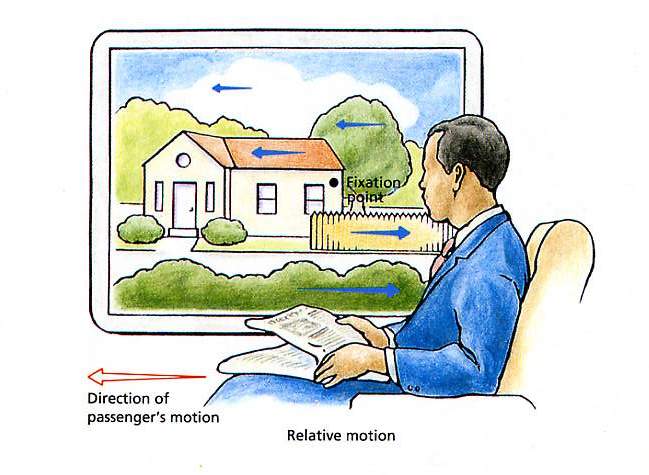When I was in high school I used to travel other states and it was mostly by taking the train. Every time I was on the train what I do was listening to music and watching landscape outside. During the traveling, the outside view was usually countryside where most of field was undeveloped or farming environment with small houses. There were usually mountains in the distance and sometimes domestic animals such as cows and horses. I am definitely sure that I recognized that as the train moves faster, objects moved and disappeared faster. However, I did not think about why and how objects outside moves faster as the train’s speed goes up. Once I have learned about motion parallax, I started to have different point of view when I am on the train and watching outside. Also, I started observed how motion parallax actually works in our daily life.
Motion parallax is one of many monocular depth cues that help people to determine distance between objects. It provides perceptual cues especially about difference in distance and motion, which is also associated with depth perception. According to our lecture notes, images closer to the observer appear to move faster across the visual field than images farther away. It means that objects that are moving faster are closer to the observer but there is more than what is from the lecture notes. It is similar to the idea of relative height, which is also one of the monocular depth cues. According to relative height depth cue, when objects are below the horizon, objects higher in the visual field appear to be farther away and when objects are above the horizon, objects lower in the visual field appear to be farther away. The reason that motion parallax is similar to relative height is because when there are no obstacles that block further view point, objects that are above the horizon moves in opposite direction than are below the horizon. Not only that, when objects are above the horizon objects move to same direction of the observer and objects lower in the visual field, which is closer to the observer, move faster than those in higher visual field.  Source for photo: http://www.rhsmpsychology.com/Handouts/monocular_cues_IV.htm
Source for photo: http://www.rhsmpsychology.com/Handouts/monocular_cues_IV.htm
I chose to respond to your post because mine was of similar style. My post included motion parallax on an airplane. As you stated in your post, it was obvious that the closer objects were moving by more quickly than the further away objects, it’s just, at the time, I didn’t realize the phenomenon that was actually taking place. It’s pretty cool when you think about it because the cow you spoke (closer to you) of and the houses (further from you) are both stationary objects, yet as you drive by, the cow seems to move a lot more quickly across your visual field than the houses, when in retrospect, they are not actually moving at all. I guess motion parallax can be viewed as an illusory concept.
I chose to reply to this blog post because I’ve posted my blog on motion parallax as well. Also, I have traveled on trains numerous times throughout my life and I have noticed, like I have said in my blog post about driving in a car, objects closer appear to move faster than objects farther away in my visual field. I never really took into consider that motion parallax is a huge determination about distance from where I am to where the object actually is. I liked how you mentioned motion parallax is similar to relative height because it is in some way. I enjoyed reading this blog. Great job!